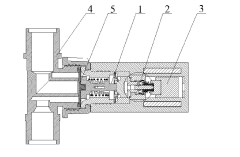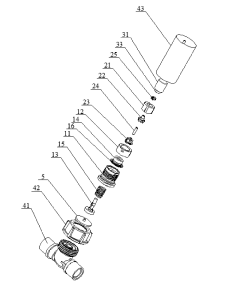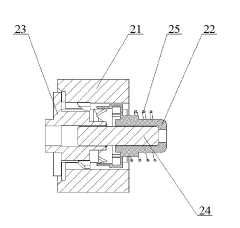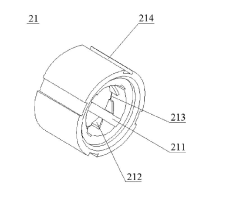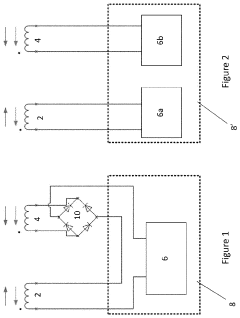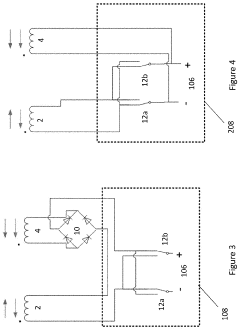Use of Solenoid Valves in Advanced Drone Fluid Systems
JUL 23, 20259 MIN READ
Generate Your Research Report Instantly with AI Agent
Patsnap Eureka helps you evaluate technical feasibility & market potential.
Solenoid Valve Tech Evolution in Drones
The evolution of solenoid valve technology in drones has been marked by significant advancements, driven by the increasing demand for more sophisticated and efficient fluid control systems in unmanned aerial vehicles. Initially, solenoid valves in drones were primarily used for basic functions such as fuel control and payload release. However, as drone technology progressed, the role of solenoid valves expanded to encompass more complex fluid management tasks.
In the early stages of drone development, solenoid valves were relatively simple and bulky, often limiting their application in smaller UAVs. The first generation of drone-specific solenoid valves focused on miniaturization and weight reduction, allowing for integration into a wider range of drone sizes and types. This period saw the introduction of compact, lightweight valves that could handle the basic fluid control needs of early commercial and military drones.
As drone capabilities advanced, so did the requirements for fluid systems. The second generation of solenoid valves for drones introduced improved precision and faster response times. These advancements were crucial for applications requiring rapid and accurate fluid control, such as in agricultural spraying drones or in drones used for aerial firefighting. During this phase, manufacturers began to develop valves specifically designed for the unique operating conditions of drones, including resistance to vibration and extreme temperatures.
The third generation of solenoid valve technology in drones focused on energy efficiency and integration with electronic control systems. This era saw the development of low-power solenoid valves that could operate for extended periods on battery power, a critical feature for long-endurance drones. Additionally, these valves were designed to interface seamlessly with drone flight controllers and onboard computers, allowing for more sophisticated fluid management strategies.
Recent advancements have pushed the boundaries of solenoid valve technology in drones even further. The latest generation of valves incorporates smart features such as self-diagnostics, predictive maintenance capabilities, and the ability to adjust performance parameters in real-time based on flight conditions. These innovations have significantly enhanced the reliability and adaptability of drone fluid systems.
Furthermore, the materials used in solenoid valve construction have evolved to meet the specific needs of drone applications. Advanced composites and alloys have been employed to create valves that are not only lighter but also more resistant to corrosion and wear, extending the operational life of drone fluid systems.
The future of solenoid valve technology in drones is likely to see continued miniaturization, increased energy efficiency, and further integration with artificial intelligence and IoT systems. These advancements will enable even more precise and autonomous fluid control, opening up new possibilities for drone applications across various industries.
In the early stages of drone development, solenoid valves were relatively simple and bulky, often limiting their application in smaller UAVs. The first generation of drone-specific solenoid valves focused on miniaturization and weight reduction, allowing for integration into a wider range of drone sizes and types. This period saw the introduction of compact, lightweight valves that could handle the basic fluid control needs of early commercial and military drones.
As drone capabilities advanced, so did the requirements for fluid systems. The second generation of solenoid valves for drones introduced improved precision and faster response times. These advancements were crucial for applications requiring rapid and accurate fluid control, such as in agricultural spraying drones or in drones used for aerial firefighting. During this phase, manufacturers began to develop valves specifically designed for the unique operating conditions of drones, including resistance to vibration and extreme temperatures.
The third generation of solenoid valve technology in drones focused on energy efficiency and integration with electronic control systems. This era saw the development of low-power solenoid valves that could operate for extended periods on battery power, a critical feature for long-endurance drones. Additionally, these valves were designed to interface seamlessly with drone flight controllers and onboard computers, allowing for more sophisticated fluid management strategies.
Recent advancements have pushed the boundaries of solenoid valve technology in drones even further. The latest generation of valves incorporates smart features such as self-diagnostics, predictive maintenance capabilities, and the ability to adjust performance parameters in real-time based on flight conditions. These innovations have significantly enhanced the reliability and adaptability of drone fluid systems.
Furthermore, the materials used in solenoid valve construction have evolved to meet the specific needs of drone applications. Advanced composites and alloys have been employed to create valves that are not only lighter but also more resistant to corrosion and wear, extending the operational life of drone fluid systems.
The future of solenoid valve technology in drones is likely to see continued miniaturization, increased energy efficiency, and further integration with artificial intelligence and IoT systems. These advancements will enable even more precise and autonomous fluid control, opening up new possibilities for drone applications across various industries.
Drone Fluid System Market Analysis
The drone fluid system market is experiencing significant growth, driven by the increasing adoption of advanced unmanned aerial vehicles (UAVs) across various industries. This market segment encompasses the components and systems responsible for managing and distributing fluids within drones, including fuel, coolants, and hydraulic fluids. Solenoid valves play a crucial role in these systems, offering precise control and efficient fluid management.
The global drone market is projected to expand rapidly, with a compound annual growth rate (CAGR) exceeding 15% over the next five years. This growth is primarily fueled by the rising demand for drones in commercial applications such as agriculture, construction, and logistics. As drones become more sophisticated and capable of carrying heavier payloads for longer durations, the need for advanced fluid systems, including those utilizing solenoid valves, is expected to increase proportionally.
In the agriculture sector, drones equipped with precision spraying systems are gaining traction for crop management and pest control. These applications require highly accurate fluid delivery systems, where solenoid valves are essential for controlling the flow and distribution of pesticides and fertilizers. The market for agricultural drones is anticipated to grow substantially, driving demand for advanced fluid systems and components.
The construction and infrastructure inspection industries are also significant contributors to the drone fluid system market growth. Drones used in these sectors often require specialized fluid systems for tasks such as concrete spraying or leak detection. Solenoid valves in these applications ensure precise control of fluid flow, enhancing the efficiency and effectiveness of drone operations.
Emerging technologies, such as hydrogen fuel cell-powered drones, are creating new opportunities for fluid system manufacturers. These drones require complex fuel management systems, including high-precision solenoid valves for hydrogen gas control. As the adoption of alternative energy sources in drones increases, the demand for specialized fluid systems and components is expected to rise.
The defense and security sectors remain significant drivers of the drone fluid system market. Military drones often incorporate advanced fluid systems for fuel management, weapon deployment, and sensor cooling. Solenoid valves in these applications must meet stringent performance and reliability standards, creating a niche market for high-performance fluid system components.
Geographically, North America and Asia-Pacific are the leading regions in the drone fluid system market. North America's dominance is attributed to its advanced aerospace industry and high adoption of drones in commercial and military applications. The Asia-Pacific region, particularly China, is experiencing rapid growth due to increasing investments in drone technology and expanding applications in agriculture and urban management.
The global drone market is projected to expand rapidly, with a compound annual growth rate (CAGR) exceeding 15% over the next five years. This growth is primarily fueled by the rising demand for drones in commercial applications such as agriculture, construction, and logistics. As drones become more sophisticated and capable of carrying heavier payloads for longer durations, the need for advanced fluid systems, including those utilizing solenoid valves, is expected to increase proportionally.
In the agriculture sector, drones equipped with precision spraying systems are gaining traction for crop management and pest control. These applications require highly accurate fluid delivery systems, where solenoid valves are essential for controlling the flow and distribution of pesticides and fertilizers. The market for agricultural drones is anticipated to grow substantially, driving demand for advanced fluid systems and components.
The construction and infrastructure inspection industries are also significant contributors to the drone fluid system market growth. Drones used in these sectors often require specialized fluid systems for tasks such as concrete spraying or leak detection. Solenoid valves in these applications ensure precise control of fluid flow, enhancing the efficiency and effectiveness of drone operations.
Emerging technologies, such as hydrogen fuel cell-powered drones, are creating new opportunities for fluid system manufacturers. These drones require complex fuel management systems, including high-precision solenoid valves for hydrogen gas control. As the adoption of alternative energy sources in drones increases, the demand for specialized fluid systems and components is expected to rise.
The defense and security sectors remain significant drivers of the drone fluid system market. Military drones often incorporate advanced fluid systems for fuel management, weapon deployment, and sensor cooling. Solenoid valves in these applications must meet stringent performance and reliability standards, creating a niche market for high-performance fluid system components.
Geographically, North America and Asia-Pacific are the leading regions in the drone fluid system market. North America's dominance is attributed to its advanced aerospace industry and high adoption of drones in commercial and military applications. The Asia-Pacific region, particularly China, is experiencing rapid growth due to increasing investments in drone technology and expanding applications in agriculture and urban management.
Solenoid Valve Challenges in Drones
The integration of solenoid valves in advanced drone fluid systems presents several significant challenges that researchers and engineers must address. One of the primary obstacles is the miniaturization of valve components without compromising performance. As drones continue to decrease in size and weight, the demand for compact and lightweight solenoid valves intensifies. However, reducing the size of these valves often leads to a decrease in flow capacity and precision control, which can negatively impact the overall efficiency of the fluid system.
Another critical challenge is power consumption. Drones operate on limited battery power, and every component must be optimized for energy efficiency. Traditional solenoid valves can be power-hungry, especially when maintaining a specific position for extended periods. This power draw can significantly reduce flight time and operational range. Developing low-power solenoid valves that can operate effectively within the constraints of a drone's power system is crucial for advancing this technology.
Reliability and durability pose additional challenges in the harsh operating conditions experienced by drones. Solenoid valves must withstand vibrations, temperature fluctuations, and potential impacts during flight and landing. The need for valves that can maintain consistent performance over numerous cycles without failure is paramount. Moreover, the valves must be resistant to contamination from environmental factors such as dust and moisture, which can compromise their functionality.
Response time is another critical factor that engineers must optimize. In advanced drone applications, such as precision agriculture or emergency response, rapid and accurate fluid control is essential. Solenoid valves need to actuate quickly and precisely to meet the demands of these applications. However, improving response time often conflicts with other design goals, such as power efficiency and miniaturization.
The complexity of fluid control in three-dimensional space adds another layer of difficulty. Drones operate in various orientations and are subject to sudden movements, which can affect fluid dynamics within the system. Designing solenoid valves that can maintain consistent performance regardless of the drone's orientation or movement patterns is a significant engineering challenge.
Lastly, the integration of solenoid valves with advanced control systems and sensors presents both opportunities and challenges. While smart valves can offer improved precision and adaptability, they also introduce complexity in terms of software integration, data processing, and potential points of failure. Balancing the benefits of advanced control with the need for simplicity and reliability is an ongoing challenge in the development of drone fluid systems.
Another critical challenge is power consumption. Drones operate on limited battery power, and every component must be optimized for energy efficiency. Traditional solenoid valves can be power-hungry, especially when maintaining a specific position for extended periods. This power draw can significantly reduce flight time and operational range. Developing low-power solenoid valves that can operate effectively within the constraints of a drone's power system is crucial for advancing this technology.
Reliability and durability pose additional challenges in the harsh operating conditions experienced by drones. Solenoid valves must withstand vibrations, temperature fluctuations, and potential impacts during flight and landing. The need for valves that can maintain consistent performance over numerous cycles without failure is paramount. Moreover, the valves must be resistant to contamination from environmental factors such as dust and moisture, which can compromise their functionality.
Response time is another critical factor that engineers must optimize. In advanced drone applications, such as precision agriculture or emergency response, rapid and accurate fluid control is essential. Solenoid valves need to actuate quickly and precisely to meet the demands of these applications. However, improving response time often conflicts with other design goals, such as power efficiency and miniaturization.
The complexity of fluid control in three-dimensional space adds another layer of difficulty. Drones operate in various orientations and are subject to sudden movements, which can affect fluid dynamics within the system. Designing solenoid valves that can maintain consistent performance regardless of the drone's orientation or movement patterns is a significant engineering challenge.
Lastly, the integration of solenoid valves with advanced control systems and sensors presents both opportunities and challenges. While smart valves can offer improved precision and adaptability, they also introduce complexity in terms of software integration, data processing, and potential points of failure. Balancing the benefits of advanced control with the need for simplicity and reliability is an ongoing challenge in the development of drone fluid systems.
Current Solenoid Valve Solutions
01 Solenoid valve design and structure
Solenoid valves are electromechanical devices that control the flow of fluids. They consist of a solenoid coil, plunger, and valve body. When energized, the coil creates a magnetic field that moves the plunger, opening or closing the valve. Various designs exist to optimize performance, including improvements in plunger shape, sealing mechanisms, and materials used.- Solenoid valve design and structure: Solenoid valves are electromechanical devices that control the flow of fluids. They consist of a solenoid coil, plunger, and valve body. When energized, the coil creates a magnetic field that moves the plunger, opening or closing the valve. Various designs exist to optimize performance, including improvements in sealing, response time, and durability.
- Application in fuel injection systems: Solenoid valves play a crucial role in fuel injection systems for internal combustion engines. They control the precise timing and amount of fuel delivered to the engine, improving efficiency and reducing emissions. Advanced designs incorporate features like multiple injection events per cycle and high-speed operation.
- Solenoid valve control systems: Control systems for solenoid valves involve electronic circuits and software algorithms to manage valve operation. These systems can include pulse-width modulation for precise control, feedback mechanisms for improved accuracy, and diagnostic features for fault detection and maintenance.
- Miniaturization and integration: Efforts to miniaturize solenoid valves and integrate them into compact systems are ongoing. This includes developing microsolenoid valves for use in microfluidic applications, as well as integrating multiple valves into manifold blocks for space-efficient fluid control systems.
- Energy efficiency and power management: Improving the energy efficiency of solenoid valves is a key area of development. This includes designing low-power solenoids, implementing energy-saving control strategies, and developing latching solenoid valves that maintain their state without continuous power input.
02 Application in fuel injection systems
Solenoid valves play a crucial role in fuel injection systems for internal combustion engines. They control the precise timing and amount of fuel delivered to the engine, improving efficiency and reducing emissions. Advanced designs incorporate features like rapid response times, high-pressure capabilities, and durability to withstand harsh engine environments.Expand Specific Solutions03 Integration with electronic control systems
Modern solenoid valves are often integrated with electronic control systems for enhanced precision and functionality. This integration allows for programmable operation, real-time adjustments, and feedback mechanisms. Advanced control systems can compensate for temperature variations, pressure changes, and wear, ensuring consistent performance over time.Expand Specific Solutions04 Energy-efficient solenoid valve designs
Innovations in solenoid valve design focus on improving energy efficiency. This includes developing low-power consumption coils, optimizing magnetic circuits, and implementing pulse-width modulation control strategies. Some designs incorporate latching mechanisms that maintain valve position without continuous power input, further reducing energy consumption.Expand Specific Solutions05 Miniaturization and specialized applications
There is a trend towards miniaturization of solenoid valves for use in compact systems and portable devices. These miniature valves maintain functionality while reducing size and weight. Specialized solenoid valves are also being developed for specific industries, such as medical devices, aerospace, and microfluidics, with unique requirements for precision, reliability, and compatibility with various fluids.Expand Specific Solutions
Key Drone Fluid System Manufacturers
The market for solenoid valves in advanced drone fluid systems is in a growth phase, driven by increasing demand for sophisticated unmanned aerial vehicles across various industries. The global market size is expanding rapidly, with projections indicating substantial growth in the coming years. Technologically, the field is advancing quickly, with companies like Eaton Corp., Robert Bosch GmbH, and SZ DJI Technology Co., Ltd. leading innovation. These firms are developing more efficient, lightweight, and precise solenoid valves tailored for drone applications. The technology's maturity is progressing, with ongoing research focused on miniaturization, energy efficiency, and integration with smart control systems, positioning the sector for continued evolution and market expansion.
Robert Bosch GmbH
Technical Solution: Bosch has developed advanced solenoid valve systems for drone fluid management, focusing on miniaturization and precision control. Their technology incorporates micro-electromechanical systems (MEMS) to create compact, lightweight valves suitable for small UAVs. These valves feature rapid response times, typically under 5 milliseconds[1], and can operate at high frequencies for precise fluid control. Bosch's solenoid valves utilize advanced materials such as high-performance polymers and corrosion-resistant alloys to withstand harsh environmental conditions often encountered in drone operations. The company has also integrated smart diagnostics and predictive maintenance capabilities into their valve systems, allowing for real-time monitoring and optimization of fluid system performance[3].
Strengths: Extensive experience in automotive and industrial fluid systems, strong R&D capabilities, and a focus on miniaturization. Weaknesses: Potentially higher cost compared to simpler solutions, and may require specialized maintenance.
Honeywell International Technologies Ltd.
Technical Solution: Honeywell has leveraged its aerospace and automation expertise to develop advanced solenoid valve technologies for drone fluid systems. Their approach focuses on high-reliability, precision control valves suitable for both commercial and military UAV applications. Honeywell's solenoid valves for drones feature advanced electromagnetic designs that allow for precise flow modulation and rapid response times, typically under 10 milliseconds[8]. The company has developed specialized valve designs that can handle multiple fluids simultaneously, enabling more complex and compact fluid management systems. Honeywell's valves incorporate advanced materials such as ceramic-coated components for improved wear resistance and extended operational life. They have also implemented smart valve technology with built-in sensors and diagnostics, allowing for predictive maintenance and real-time performance optimization. Honeywell's valve systems are designed to meet stringent aerospace standards, with some models capable of operating at altitudes up to 70,000 feet[9].
Strengths: Extensive aerospace and defense experience, focus on high-reliability and extreme environment operation, and advanced sensing and diagnostic capabilities. Weaknesses: Solutions may be overqualified and costly for simpler consumer drone applications.
Innovative Solenoid Valve Patents
Solenoid valve, spraying system and exhaust method for plant protection drone
PatentInactiveJP2022549696A
Innovation
- A solenoid valve design with a valve body module, regulation module, and electromagnetic module, where the regulation module includes a fixed shell, driving gear, rotating wheel, and spring, allowing the electromagnetic module to be energized and disconnected to control the valve's opening and closing, reducing continuous energization needs.
Heating of solenoids
PatentActiveUS20200263802A1
Innovation
- A solenoid design featuring first and second coils connected to an electrical power supply circuit, operating in two modes: one mode for self-heating with opposing current directions and another for generating a magnetic force with currents flowing in the same direction, utilizing the same coils for both functions without additional heating components.
Regulatory Framework for Drone Components
The regulatory framework for drone components, particularly in the context of solenoid valves used in advanced fluid systems, is a complex and evolving landscape. As unmanned aerial vehicles (UAVs) become increasingly sophisticated, regulatory bodies worldwide are adapting their guidelines to ensure safety, reliability, and compliance in drone operations.
In the United States, the Federal Aviation Administration (FAA) plays a pivotal role in regulating drone components. The FAA's Part 107 rules, while primarily focused on operational aspects, also indirectly influence component requirements. For instance, the weight limitations imposed on drones necessitate the use of lightweight yet efficient components, including solenoid valves in fluid systems. The FAA also mandates rigorous testing and certification processes for critical drone components to ensure they meet safety standards.
The European Union Aviation Safety Agency (EASA) has implemented a comprehensive regulatory framework for drones, including specific provisions for components. The EASA's regulations categorize drones based on risk levels, with each category having distinct requirements for components. Solenoid valves used in advanced fluid systems would likely fall under the more stringent requirements for higher-risk categories, necessitating thorough documentation and testing.
In China, the Civil Aviation Administration of China (CAAC) has established regulations that address drone components, including those used in fluid systems. The CAAC's approach emphasizes the importance of reliable and safe components, with specific attention to critical systems that could affect flight performance.
International standards organizations, such as the International Organization for Standardization (ISO), have also developed guidelines relevant to drone components. ISO 21384-3, for example, provides specifications for unmanned aircraft systems, including requirements for components like solenoid valves in fluid systems. These standards often serve as a basis for national regulations and industry best practices.
Regulatory frameworks typically address several key aspects of drone components, including performance requirements, durability standards, electromagnetic compatibility, and environmental testing. For solenoid valves in advanced drone fluid systems, regulations may specify operational temperature ranges, pressure tolerances, response times, and fail-safe mechanisms.
As drone technology continues to advance, regulatory bodies are increasingly focusing on the integration of smart components and systems. This trend is likely to impact the regulation of solenoid valves, potentially requiring enhanced monitoring capabilities, data logging, and compatibility with drone health monitoring systems.
In the United States, the Federal Aviation Administration (FAA) plays a pivotal role in regulating drone components. The FAA's Part 107 rules, while primarily focused on operational aspects, also indirectly influence component requirements. For instance, the weight limitations imposed on drones necessitate the use of lightweight yet efficient components, including solenoid valves in fluid systems. The FAA also mandates rigorous testing and certification processes for critical drone components to ensure they meet safety standards.
The European Union Aviation Safety Agency (EASA) has implemented a comprehensive regulatory framework for drones, including specific provisions for components. The EASA's regulations categorize drones based on risk levels, with each category having distinct requirements for components. Solenoid valves used in advanced fluid systems would likely fall under the more stringent requirements for higher-risk categories, necessitating thorough documentation and testing.
In China, the Civil Aviation Administration of China (CAAC) has established regulations that address drone components, including those used in fluid systems. The CAAC's approach emphasizes the importance of reliable and safe components, with specific attention to critical systems that could affect flight performance.
International standards organizations, such as the International Organization for Standardization (ISO), have also developed guidelines relevant to drone components. ISO 21384-3, for example, provides specifications for unmanned aircraft systems, including requirements for components like solenoid valves in fluid systems. These standards often serve as a basis for national regulations and industry best practices.
Regulatory frameworks typically address several key aspects of drone components, including performance requirements, durability standards, electromagnetic compatibility, and environmental testing. For solenoid valves in advanced drone fluid systems, regulations may specify operational temperature ranges, pressure tolerances, response times, and fail-safe mechanisms.
As drone technology continues to advance, regulatory bodies are increasingly focusing on the integration of smart components and systems. This trend is likely to impact the regulation of solenoid valves, potentially requiring enhanced monitoring capabilities, data logging, and compatibility with drone health monitoring systems.
Environmental Impact Assessment
The use of solenoid valves in advanced drone fluid systems presents both potential benefits and environmental concerns that warrant careful consideration. These valves play a crucial role in controlling fluid flow within drones, impacting their performance and efficiency. However, their implementation also carries environmental implications that must be assessed.
One primary environmental consideration is the energy consumption associated with solenoid valve operation. While these valves offer precise control, they require electrical power to function, potentially increasing the overall energy demands of drone systems. This increased energy consumption could lead to shorter flight times or the need for larger batteries, which in turn may result in increased resource extraction and manufacturing processes.
The materials used in solenoid valve construction also merit environmental scrutiny. Many valves incorporate metals and plastics, which have varying degrees of environmental impact in terms of production, disposal, and potential for recycling. The use of rare earth metals in some high-performance solenoid valves raises additional concerns regarding resource depletion and the environmental consequences of mining activities.
Fluid leakage is another environmental factor to consider. While solenoid valves are designed to prevent leaks, the potential for malfunction or wear over time exists. Any leakage of hydraulic fluids or other substances used in drone systems could have detrimental effects on soil, water sources, or ecosystems if drones are operated in sensitive environmental areas.
On the positive side, the precise control offered by solenoid valves can contribute to more efficient fluid management in drones. This improved efficiency may lead to reduced fuel consumption or more optimal use of onboard resources, potentially mitigating some environmental impacts associated with drone operations.
The noise generated by solenoid valve operation, although typically minimal, should be evaluated in the context of drone applications in noise-sensitive areas. While the valves themselves may not significantly contribute to overall drone noise levels, their role in fluid system management could indirectly influence the acoustic footprint of drone operations.
End-of-life considerations for drones equipped with solenoid valves also warrant attention. The complexity added by these components may complicate recycling or disposal processes, necessitating specialized handling to minimize environmental impact. Developing effective recycling strategies for these advanced fluid systems will be crucial as the drone industry continues to expand.
In conclusion, while solenoid valves offer significant advantages for advanced drone fluid systems, their environmental impact must be carefully assessed and managed. Balancing the benefits of improved performance and efficiency against potential environmental drawbacks will be essential for sustainable development in the drone industry.
One primary environmental consideration is the energy consumption associated with solenoid valve operation. While these valves offer precise control, they require electrical power to function, potentially increasing the overall energy demands of drone systems. This increased energy consumption could lead to shorter flight times or the need for larger batteries, which in turn may result in increased resource extraction and manufacturing processes.
The materials used in solenoid valve construction also merit environmental scrutiny. Many valves incorporate metals and plastics, which have varying degrees of environmental impact in terms of production, disposal, and potential for recycling. The use of rare earth metals in some high-performance solenoid valves raises additional concerns regarding resource depletion and the environmental consequences of mining activities.
Fluid leakage is another environmental factor to consider. While solenoid valves are designed to prevent leaks, the potential for malfunction or wear over time exists. Any leakage of hydraulic fluids or other substances used in drone systems could have detrimental effects on soil, water sources, or ecosystems if drones are operated in sensitive environmental areas.
On the positive side, the precise control offered by solenoid valves can contribute to more efficient fluid management in drones. This improved efficiency may lead to reduced fuel consumption or more optimal use of onboard resources, potentially mitigating some environmental impacts associated with drone operations.
The noise generated by solenoid valve operation, although typically minimal, should be evaluated in the context of drone applications in noise-sensitive areas. While the valves themselves may not significantly contribute to overall drone noise levels, their role in fluid system management could indirectly influence the acoustic footprint of drone operations.
End-of-life considerations for drones equipped with solenoid valves also warrant attention. The complexity added by these components may complicate recycling or disposal processes, necessitating specialized handling to minimize environmental impact. Developing effective recycling strategies for these advanced fluid systems will be crucial as the drone industry continues to expand.
In conclusion, while solenoid valves offer significant advantages for advanced drone fluid systems, their environmental impact must be carefully assessed and managed. Balancing the benefits of improved performance and efficiency against potential environmental drawbacks will be essential for sustainable development in the drone industry.
Unlock deeper insights with Patsnap Eureka Quick Research — get a full tech report to explore trends and direct your research. Try now!
Generate Your Research Report Instantly with AI Agent
Supercharge your innovation with Patsnap Eureka AI Agent Platform!
